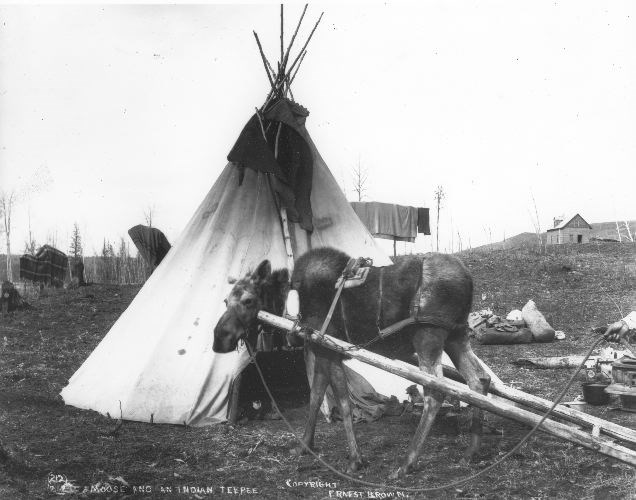In the last episode, Caribou Joe realizes that he may not be up for the challenge of tracking a Bigfoot, so he faced an important decision.
"What you got in here Sandy?" asked Joe. He was referring to the bowl of soup the trapper had just served. The first thing Sandy did on their return to the cabin was to get the fire started and to heat up the large cast iron cooking pot that was already half full of a chunky trap-line stew.
"Well," said the old man, "I just added some water, a little dried skunk cabbage and some more rat root."
"Did you say rat rot?"
"No, no. That's rat root. It's my secret ingredient. Of course there's plenty beans and some pieces of porcupine, rabbit and moose. What ever I got I just cut it up and throw it in. But, you know, rat root is the best medicine around. When I can't get my hands on some spuds I use rat root. I've been digging up herbs and roots since I was a young'un.
"And you can use rat root for medicine?" Joe was curious.
"It's good for a sore throat or stomach pain," offered Sandy. "Back in Alberta, I lived with some Cree and Chipewan Indians. Everyone's got a trap-line up near Fort McKay. Besides the trapping and trading we did plenty of good digging. That rat root's got a bitter taste but nothing to cause offense in my stew."
"What else do you gather up?" Joe continued eating his stew.
"Well, in Alberta I used to dig for blood root, yellow root and Virginia snake root. But, here at Tte Jaune I collect red willow bark, bearberries and green kinnikinnick. I shave the red willow with a knife and mix it together with tobacco, the kinnikinnick and dried bearberries. Makes a powerful good smoke. I use birch bark for paper to roll my cigarettes. Been trading with the local Shuswup here too. When I get an extra moose hide I swap for smoked salmon. I include the moose brains with the trade. The Indians can make about twelve pairs of moccasins from one moose hide and they use brains to soften it"
Joe noticed Sandy's moose-hide mukluks hanging up near the door. "Did the Shuswup make them there skins?" he asked, pointing in the direction of the door.
"No, I make my own footwear when it comes to mukluks. It takes about three days of hard work just to soften up the hide."
"And, you use moose brain?"
"The way I do it," explained Sandy, "is different from the Indians. They use ashes and brains and I use one moose brain, one cup of soap, and half a pound of lard. There's a lot of scraping too. The Shuswap use a moose leg-bone scrapper but I have my own design. It's a piece of iron and an old axe handle. I sharpen it til there's a good scrapping edge but not sharp enough to cut the hide. It scrapes damn good."
"I had some caribou brains for dinner one time over at Starvation Flats," bragged Joe.
"You know, moose brains taste good too . . . specially with cranberries and moose milk," countered the trapper.
"Moose milk? How do you get moose milk?" Joe inquired.
"You take it from a moose that's been freshly killed," replied the trapper. "It's a great meal when you can get it." Both men laughed out loud.
"Judging from the look on your face, Joe, I suppose you thought I kept a cow moose out the back just for fresh Moose Milk," wagered the trapper.
"Ya," replied Joe, "I was wondering about the milk."
"Well," said Sandy, "Don't laugh. Down in Morinville, Alberta some folks raised a cow and bull moose and trained them to pull a wagon."
"You don't say?" Now Joe was amazed.
"I do say," replied Sandy. "I seen it with my own eyes. Them moose pull that wagon every year in the big parade in Edmonton. I heard they haul letters, packages and such, once a week , from Morinville to the city." He slapped his leg and laughed once again. "That's a twenty mile mail-run."
Trapper Sandy and Caribou Joe sat for an hour or two exchanging sasquatch stories and drinking Shuswap tea spiked with some of Sandy's stump whiskey, which, by no great coincidence, was one of the last few bottles that Joe had sold at Mile 49 a few months earlier.
Joe left the trapper's home and returned to his own. He reached the Wall brothers bunkhouse just after dark and was pleased two find the place warm and cozy. The boys had a good fire going in the cook-stove. Joe climbed into his bed, after removing his clothes and soggy boots and fell fast asleep. No doubt, he slept well that night.
In the next episode, Springtime At The Cache, the dock-yards at Mile 53 were a busy place in April of 1913. Here, Joe finds out about a new opportunity that will send him down the Fraser River in a canoe.



